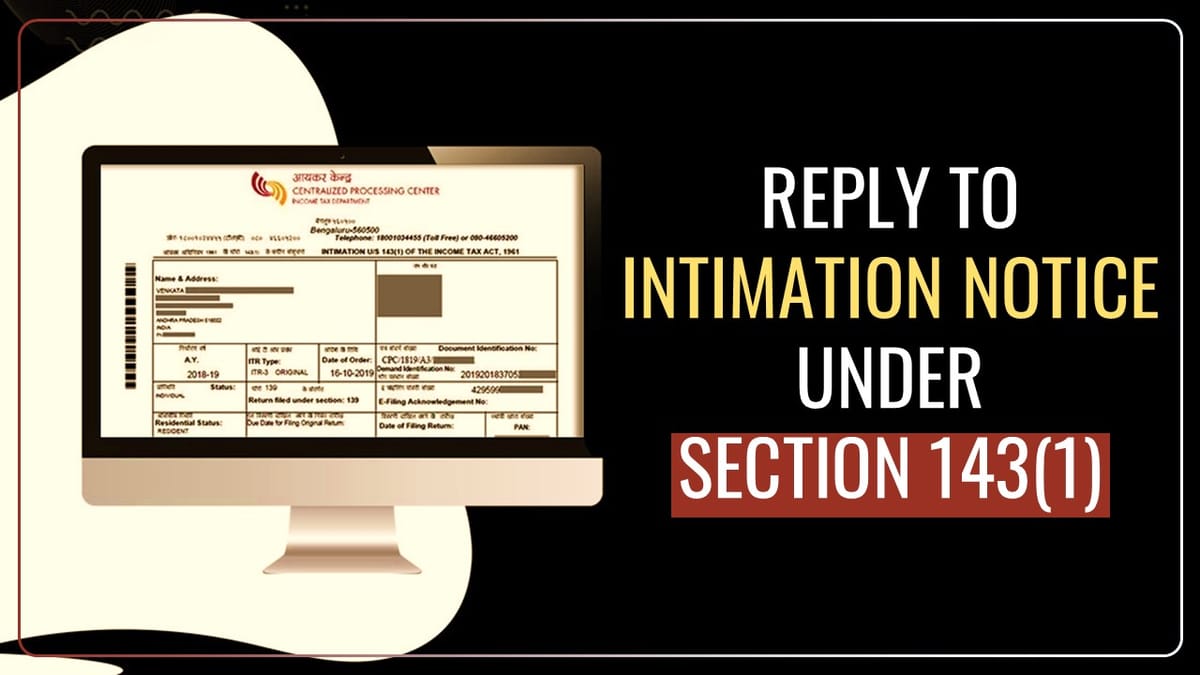Individuals receive an intimation notice from the IT department after processing of ITR. Know how to reply to this notice.
Reetu | Aug 20, 2024 |

Know How to reply Section 143(1) Income Tax Notice received after filing ITR
Completing the income tax return (ITR) filing process goes beyond verification. Individuals’ income tax departments begin processing ITRs after they have verified their tax returns. Individuals receive an intimation notice from the income tax department once their ITR has been processed.
This notice is being sent under Section 143(1) of the Income Tax Act of 1961. The income tax notice will be sent to the taxpayer’s registered email address with the tax department. Furthermore, the taxpayer will receive an SMS to their registered mobile number informing them that the communication has been delivered to the registered email address.
An individual should read this income tax notice. This is important because the notice informs you whether your income tax calculation in your ITR matches the tax department’s calculation based on the information they have.
The time limit for issuing an intimation notice has been extended by three months, beginning April 1, 2021. The intimation notice should be sent out within 9 months of the end of the financial year in which the tax return is filed.
For the financial year 2023-24 (assessment year 2024-25), the income tax return filing deadline was July 31, 2024. As a result, the income tax department must give an intimation notice within nine months (by December 31, 2025) of the end of the financial year in which the income tax return was submitted (by March 31, 2025).
During the processing of your ITR, the tax department checks for mathematical errors, internal discrepancies, and tax and interest computations before validating tax payments. After the ITR is processed, the tax department sends an intimation under section 143(1). It is worth noting, however, that the tax department performs an initial examination during the ITR processing. In the future, they may issue an income tax notice under a different section, demanding additional information.
The notice of intimation is a password-protected file. To view the notice that has been issued to you, enter your PAN in lowercase combined with your date of birth as the password. For example, if your PAN number is AAAAA0000A and your birth date is April 1, 1990, the password to view the document will be aaaaa000a01041990.
The first step after opening the password-protected file is to double-check the accuracy of your personal information, such as your name, address, PAN, and so on, as stated in the notice.
After checking this information, the next step is to compare the income tax computation offered by you in your ITR to the department’s computation. The intimation notice includes a table that compares the income you declared in the ITR for each category to the income determined by the income tax department. Both columns are shown next to one other for easy comparison.
The intimation notice includes information about the tax-saving deductions claimed in your ITR, as well as income information. If the income and tax-saving information match in both sections, your total income after deductions, or net taxable income, will also match.
The notice will also include your tax information, such as tax liability on net taxable income, tax relief (if any), interest under sections 234A, 234B, and 234C, late filing fees under section 234F, and total income tax liability.
If there is a difference in income within a given category if you have improperly claimed a deduction, or if there are any other calculation problems, the taxable income determined by the tax department may differ from the income you stated on your ITR. This variation can cause the department’s calculated taxable income to be greater or lower, indicating either an additional tax payment or an eligible refund.
If you are due a refund, it will be mentioned in the notification letter. However, it is crucial to know that the tax department will not send you an SMS to advise you of this. As a result, be wary of any SMSs or emails saying that you have an income tax refund awaiting you and seeking your bank information to complete the refund; this is a type of fraudulent activity that has enticed many taxpayers.
If you are due an income tax refund, the tax department will deposit it straight into the bank account you specified when filing your ITR. The government will notify you after your income tax refund has been processed, and you will not be required to give bank account details.
Follow these steps to respond to an Income Tax Notice under Section 143(1):
If the tax department does not process your tax return or you get it but do not receive an intimation notice, you can file a complaint through the new income tax portal.
In case of any Doubt regarding Membership you can mail us at contact@studycafe.in
Join Studycafe's WhatsApp Group or Telegram Channel for Latest Updates on Government Job, Sarkari Naukri, Private Jobs, Income Tax, GST, Companies Act, Judgements and CA, CS, ICWA, and MUCH MORE!"